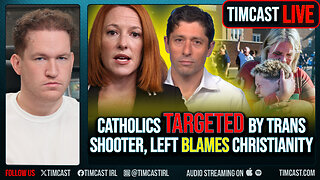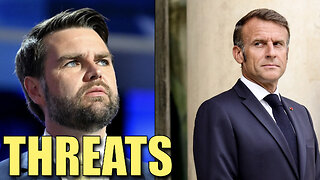Premium Only Content

Episode 1350: Can the teaching of the Church Magisterium change?
The Catholic Church Magisterium refers to the teaching authority of the Catholic Church, specifically vested in the Pope and the bishops in communion with him. The term "Magisterium" comes from the Latin word "magister," which means "teacher."
The Magisterium is responsible for preserving, interpreting, and transmitting the deposit of faith, which includes both sacred Scripture (the Bible) and sacred Tradition (the teachings passed down from the apostles). This is why many fallen away catholics don’t want to discuss the Church Magesterium or will say its too complicated. Yep being in Christ church takes work. So the full definition of the despoit of faith is
The Deposit of Faith refers to the body of revealed truth and divine revelation entrusted to the Catholic Church. It consists of two interrelated components: sacred Scripture (the Bible) and sacred Tradition (the teachings and practices passed down from the apostles).
Sacred Scripture refers to the inspired writings contained in the Bible, which is composed of the Old Testament (Hebrew Scriptures) and the New Testament. The Old Testament contains the religious texts of ancient Israel, while the New Testament contains the life, teachings, death, and resurrection of Jesus Christ, as well as the early Christian writings.
Sacred Tradition encompasses the oral teachings, practices, and beliefs handed down from the apostles and early Christian communities. It includes the teachings of the early Church Fathers, liturgical practices, creeds, councils, and other elements of the Church's living tradition. Sacred Tradition is seen as complementary to, and inseparable from, sacred Scripture, forming a unified source of divine revelation.
Together, sacred Scripture and sacred Tradition make up the Deposit of Faith. They are regarded as inspired and authoritative sources of divine revelation, communicating God's truth to humanity. The Catholic Church, through the Magisterium (teaching authority), is entrusted with preserving, interpreting, and transmitting this Deposit of Faith faithfully and authentically to successive generations.
The Deposit of Faith is considered unchanging and enduring, as it is rooted in the eternal and unchanging nature of God's revelation. The Magisterium has the responsibility to safeguard and interpret the Deposit of Faith in response to the needs and challenges of different historical and cultural contexts while remaining faithful to its core teachings.
In summary, the Deposit of Faith represents the body of revealed truth and divine revelation entrusted to the Catholic Church, consisting of sacred Scripture and sacred Tradition. It is the foundation of Catholic doctrine and provides the basis for the Church's teachings and beliefs.
We good? Now you know what the deposit of faith is.
The Church Magisterium is guided and protected by the Holy Spirit from error when it comes to matters of faith and morals.
Wait a second Walt what do you mean by Faith and Morals.
Faith and morals are two interconnected aspects of religious belief and practice.
Faith refers to the beliefs, trust, and confidence that individuals have in their religious traditions, doctrines, and teachings. It involves a personal and profound conviction in the existence of a higher power or divine being, as well as accepting and embracing the teachings and truths revealed by that higher power. In the context of the Catholic Church, faith encompasses belief in God, the divinity of Jesus Christ, the Holy Spirit, the sacraments, the resurrection, and other core tenets of Christian theology.
Morals, on the other hand, pertain to the ethical and moral principles that guide human behavior and actions. Morality involves distinguishing between right and wrong, and it encompasses values, virtues, and ethical norms that govern how individuals should live and interact with others. Moral teachings often address issues such as justice, compassion, honesty, integrity, respect for life, social responsibility, and the pursuit of the common good.
In the Catholic tradition, faith and morals are intimately connected. The teachings of the Church, as expressed by the Magisterium, provide guidance on moral matters based on the understanding of divine revelation and the natural law. These teachings aim to help individuals live in accordance with God's will and to foster a just and loving society. The moral teachings of the Church cover a wide range of topics, including human dignity, sexuality, marriage, family, social justice, and the respect for life from conception to natural death.
Both faith and morals play essential roles in the spiritual and ethical formation of Catholics, shaping their beliefs, values, and actions in accordance with the teachings of the Church. They are considered intertwined aspects of religious life, reflecting the integration of belief and practice in Catholic theology.
So back to the main point.
The Pope, as the successor of Saint Peter, is considered the supreme authority in the Catholic Church. When he speaks ex cathedra ("from the chair"), defining a doctrine or belief on faith or morals, Catholics believe his teaching is infallible. However, it is important to note that papal infallibility is only invoked in rare and specific circumstances.
My granddaughter and I discussed this authority when we did Catholic Catechism. Its so important to teach catechism when children are young and sponges.
The bishops, in communion with the Pope, also participate in the Magisterium. They have the authority to teach and interpret the faith within their respective dioceses or regions. The teachings of the Magisterium are conveyed through various means, including papal encyclicals, apostolic letters, documents of ecumenical councils, and statements issued by bishops' conferences.
Catholics are called to submit to the authority of the Magisterium and accept its teachings as a guide for their faith. The Magisterium plays a central role in preserving the unity and doctrinal integrity of the Catholic Church.
So if the million dollar question is whether the current magestrium can change the previous magestriums teachings? Pretty simple question right? Also if they can does that mean the previous magestriums teachings were wrong and or in error? You can’t have two forms of truth right?
Now listen close my fellow Catholics because you are about to be educated.
In Catholic doctrine, the teachings of the Magisterium, including those of previous popes, are considered authoritative and part of the deposit of faith. As referred to above.
The Magisterium is believed to be guided by the Holy Spirit and protected from error in matters of faith and morals. Listen up now! As such, the teachings of previous popes are considered to have enduring value and are not subject to arbitrary change by subsequent popes.
However, there is a distinction between infallible and non-infallible teachings of the Magisterium. Infallibility is a charism, which means as specific graces or gifts of the Holy Spirit that are given to individuals or groups to fulfill particular roles or ministries in the Church. These charisms are believed to be bestowed for the purpose of building up the body of Christ and carrying out the mission of the Church.
Charisms can manifest in various forms, such as preaching, teaching, healing, administration, leadership, discernment, prophecy, hospitality, or acts of compassion. These gifts are seen as empowering individuals to participate actively in the life and mission of the Church and to contribute to the building of a vibrant and holy community.
It is important to note that charisms are distinct from natural talents or acquired skills. While a person's natural abilities and skills can certainly be used in service to the Church, charisms are considered to be supernatural gifts given directly by the Holy Spirit for the benefit of the Church and its members.
These charisms are attributed to the Pope when he speaks ex cathedra on matters of faith and morals. Infallible teachings are considered to be free from error and binding on all Catholics. These teachings are rare and require specific conditions to be met.
Non-infallible teachings, on the other hand, are subject to a degree of development and clarification over time. While they carry significant weight and are to be respected, they can be subject to further theological reflection and interpretation. The Magisterium, including the Pope, can provide guidance and clarification on non-infallible teachings in response to new circumstances, social changes, or deeper theological insights.
It is important to note that any changes or developments in non-infallible teachings are expected to be consistent with the overall tradition and deposit of faith. The Magisterium, including the Pope, has the authority and responsibility to interpret and apply the teachings of previous popes and the broader tradition of the Church. However, changes or developments are approached with caution and a deep respect for the continuity of Catholic doctrine.
Overall, while the teachings of previous popes are highly regarded and influential, the Magisterium, including the current Pope, has the authority to provide further clarification, development, or interpretation of non-infallible teachings while remaining faithful to the overall deposit of faith.
So the big question for Traditional Catholics is the way a catholic mass is said considered an infallible teaching?
No, the way a Catholic Mass is celebrated, including the specific liturgical rituals and practices, is not considered an infallible teaching. The liturgical form and elements of the Mass, such as the prayers, gestures, and readings, are part of the Church's liturgical tradition and have developed over time.
While the Catholic Church holds that the liturgy is an important and sacred aspect of its worship, the specific expressions of the Mass can vary to some extent across different cultures and regions, while still adhering to the essential elements and principles of the Mass.
The celebration of the Mass is governed by liturgical norms and guidelines set forth by the Church's authorities, particularly the Congregation for Divine Worship and the Discipline of the Sacraments. These guidelines provide a framework to ensure the essential integrity and reverence of the liturgy, while allowing for legitimate adaptations and variations.
It's important to note that the liturgical norms and guidelines can be modified or updated by the competent Church authorities, such as the Pope or the bishops, to address pastoral needs or to enhance the liturgical life of the faithful. However, these modifications do not fall under the charism of infallibility. They are considered within the sphere of the Church's disciplinary authority and pastoral discernment.
So the specific way a Catholic Mass is celebrated, including its liturgical elements and practices, is not considered an infallible teaching. While the Mass is a central and sacred act of worship, the Church has the authority to regulate and adapt the liturgical expressions within the broader framework of the liturgical tradition and norms.
So did the Council of Trent, held between 1545 and 1563, addressed the issue of the liturgy, including the use of Latin in the Mass. The council affirmed the use of Latin as the language of the Roman Rite, but it did not explicitly state that the Latin Mass could never be abrogated.
The Council of Trent aimed to address the challenges posed by the Protestant Reformation and reaffirm Catholic doctrine and practices. In its documents related to the liturgy, particularly the "Session XXII - Doctrina de Sacrifício Missae" (Session 22 - Doctrine on the Sacrifice of the Mass), 1562 (400 years before VII) the council emphasized the sacrificial nature of the Mass and the importance of preserving the unity, integrity, and reverence of the liturgy.
While the council emphasized the use of Latin in the liturgy as the universal language of the Roman Rite, it did not make an infallible declaration stating that the Latin Mass could never be abrogated or that the vernacular language could never be used in the Mass. The council's focus was primarily on the doctrinal aspects of the Mass, rather than specific liturgical practices or languages.
It's important to note that in subsequent years, particularly following the Second Vatican Council (1962-1965), there were changes and developments in the Catholic Church's liturgical practices. The Second Vatican Council's Constitution on the Sacred Liturgy, "Sacrosanctum Concilium," called for a greater use of the vernacular language in the Mass while still preserving the use of Latin in certain parts of the liturgy.
In 2007, Pope Benedict XVI issued a motu proprio titled "Summorum Pontificum," which aimed to make the celebration of the Latin Mass (referred to as the Extraordinary Form) more widely available. This motu proprio clarified that the Latin Mass was never abrogated and could be celebrated by priests who have been granted permission to do so.
In summary, while the Council of Trent affirmed the use of Latin in the liturgy, it did not explicitly state that the Latin Mass could never be abrogated. Subsequent developments in the liturgical practices of the Catholic Church have allowed for a greater use of the vernacular language while still recognizing the value and place of the Latin language in certain aspects of the liturgy.
It should be noted that:
The Council of Trent, a significant ecumenical council of the Catholic Church, took place over several years, from 1545 to 1563. (18 years) During the council, there were several popes who served consecutively. The popes during the Council of Trent were:
Pope Paul III (1534-1549): Pope Paul III convoked the Council of Trent in 1545. He initiated the council as a response to the Protestant Reformation and sought to address theological and disciplinary matters within the Church.
Pope Julius III (1550-1555): Pope Julius III presided over a portion of the Council of Trent. His pontificate coincided with the later sessions of the council, and he played a role in its deliberations.
Pope Marcellus II (1555): Pope Marcellus II became Pope for a brief period in 1555 but died just a few weeks after his election. He did not have a significant impact on the proceedings of the Council of Trent.
Pope Paul IV (1555-1559): Pope Paul IV was the pope during the later sessions of the Council of Trent. However, he did not actively participate in the council, and his pontificate was marked by other significant events and reforms.
Pope Pius IV (1559-1565): Pope Pius IV presided over the final sessions of the Council of Trent and brought the council to a close in 1563. He played a crucial role in implementing and promulgating the council's decrees.
So the ultimate question is whether Pope Pius V (1566-1572) did say that the traditional Mass as outlined by the Council of Trent could never be abrogated?
Yes he did. In his bull Quo Primum (From the First), he wrote:
We decree and declare that the entire rite of the Mass, which was published by Our predecessor of happy memory, Pope Pius V, and is contained in the missal printed in the Roman type, and which is now in common use in the Roman Church and in other churches throughout the world, shall be in perpetual use in the whole Catholic Church, without any alteration whatever.
This bull was issued in 1570, shortly after the Council of Trent had concluded. It was intended to ensure that the traditional Mass would remain the standard form of the liturgy in the Catholic Church, in the face of the Protestant Reformation's challenge to traditional Catholic beliefs and practices.
Quo Primum has been interpreted by some as meaning that the traditional Mass can never be abrogated, even by a future pope. However, other scholars have argued that this interpretation is too literal. They point out that the bull does not explicitly say that the traditional Mass can never be changed, but only that it shall be in perpetual use. This leaves open the possibility that the traditional Mass could be modified in the future, if there were a compelling reason to do so.
So the Million dollar question for Catholics is can a papal bull be overturned, or is it forever part of the church magestroium especially when a pope states it excatherdra. It can be overturned but it is not an easy process. In order for a papal bull to be overturned, it must be shown that the bull is in error or that it is no longer applicable to the current circumstances. This can be a difficult task, as papal bulls are considered to be infallible statements of the pope's teaching authority.
There have been a few cases in history where papal bulls have been overturned. For example, the bull Unam Sanctam, which was issued by Pope Boniface VIII in 1302, claimed that the pope had supreme authority over both the spiritual and temporal realms. This bull was overturned by the Council of Constance in 1415.
Another example is the bull Inter Caetera, which was issued by Pope Alexander VI in 1493. This bull gave Spain and Portugal the right to colonize the Americas. The bull was overturned by the Second Vatican Council in 1965.
The process of overturning a papal bull is typically initiated by a group of theologians or canon lawyers who argue that the bull is in error. If their arguments are persuasive, the case may be taken up by a higher authority, such as a cardinal or the pope himself. If the pope decides that the bull is indeed in error, he can issue a new bull that overturns the old one.
It is important to note that the overturning of a papal bull is a rare event. It only happens when there is a clear consensus that the bull is in error or that it is no longer applicable to the current circumstances. Even then, the process can be lengthy and difficult.
in his 2007 motu proprio Summorum Pontificum, he stated that the 1962 Roman Missal, which is the form of the Mass used in the traditional Latin Mass, was "never abrogated." This means that the traditional Latin Mass was never officially outlawed or forbidden by the Catholic Church.
However, Pope Benedict did say that the traditional Latin Mass was not the "ordinary" form of the Mass, but rather the "extraordinary" form. This means that it was not the form of the Mass that was intended to be used by the majority of Catholics. Instead, it was intended to be used by those who had a particular attachment to it.
Pope Benedict's decision to allow the celebration of the traditional Latin Mass was controversial, and it was met with opposition from some quarters of the Catholic Church. However, it was also welcomed by many traditionalists, who had been concerned about the decline of the traditional Latin Mass in the years since the Second Vatican Council.
In 2021, Pope Francis issued a new motu proprio, Traditionis Custodes, which restricted the celebration of the traditional Latin Mass. This motu proprio was met with further controversy, and it remains to be seen how it will be implemented in the years to come.
The Catholic belief in Latin that means "how we pray is how we believe" is lex orandi, lex credendi. It is a Latin phrase that literally means "the law of praying is the law of believing." This means that the way we pray reflects our beliefs, and our beliefs shape the way we pray.
The phrase lex orandi, lex credendi is often used to explain the relationship between the liturgy and theology. The liturgy is the public worship of the Church, and it includes the prayers, hymns, and rituals that we use to express our faith. Theology is the study of God and our relationship to God, and it includes the beliefs that we hold about God, the world, and ourselves.
The lex orandi, lex credendi principle suggests that there is a close relationship between the liturgy and theology. The way we pray in the liturgy reflects our beliefs about God, and our beliefs about God shape the way we pray. This means that the liturgy can be a powerful tool for teaching and catechesis. By praying the liturgy, we can come to a deeper understanding of our faith.
The lex orandi, lex credendi principle is also important for understanding the development of doctrine. The Church's beliefs have evolved over time, and the liturgy has played a role in this process. As the Church's understanding of God has deepened, so too has the liturgy. The prayers, hymns, and rituals of the liturgy have been shaped by the Church's beliefs, and they in turn have helped to shape those beliefs.
The lex orandi, lex credendi principle is a reminder that prayer and belief are inextricably linked. The way we pray is how we believe, and the way we believe shapes the way we pray. The liturgy is a powerful tool for teaching and catechesis, and it can help us to come to a deeper understanding of our faith.
-
 20:03
20:03
Adam Does Movies
2 hours agoAlien: Earth Episode 1 - Recrap
24 -
 15:38
15:38
IsaacButterfield
9 hours ago $0.12 earnedExploiting His Baby For Views (The Island Boys)
8952 -
 LIVE
LIVE
The Boomer Effect
5 hours agoBuy American and Build America
58 watching -
 1:59:46
1:59:46
The Charlie Kirk Show
2 hours agoShould Taylor Swift Submit? + What's Wrong In Minneapolis? + MAHA vs. CDC | 8.28.2025
26K12 -
 50:23
50:23
The White House
1 hour agoPress Secretary Karoline Leavitt Briefs Members of the Media, Aug. 28, 2025
3.05K17 -
 1:01:34
1:01:34
Timcast
3 hours agoCatholics Targeted By TRANS Shooter, Left Blames CHRISTIANITY
129K97 -
 2:09:57
2:09:57
Steven Crowder
5 hours agoTotal Failure: Unpacking The Media's Evil Reaction to the Minneapolis Church Shooting
284K276 -
 2:05:26
2:05:26
Side Scrollers Podcast
3 hours ago4Chan SUES UK Government + Craig Has Mental Illness Fatigue + Knight Rider REBOOT | Side Scrollers
6.42K1 -
 1:17:10
1:17:10
Sean Unpaved
3 hours agoColt Knost Unplugged: Golf, 2025 Ryder Cup, & Football Fever
12.3K -
 18:12
18:12
Neil McCoy-Ward
2 hours agoIt’s About To Get Ugly Between JD Vance and Macron
4.94K2